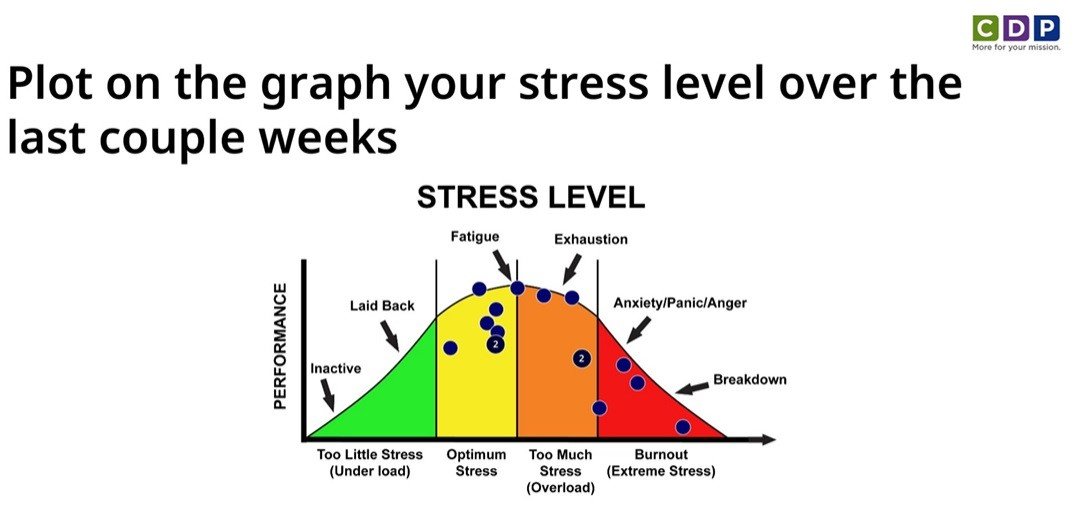How To Navigate a Flexible Vacation Policy and Combat Burnout
Burnout has been recognized and studied for decades, but recently you see the topic everywhere with more and more workers feeling that impact on both the company and personal level. CDP has taken steps to define, understand, measure and combat burnout.
Our first step in combatting burnout has been to define and measure it. Using a visual graph via the anonymous real-time feedback tool Mentimeter, we asked employees to plot where they felt their stress level was on the Yerkes-Dodson Human Performance and Stress Curve over the last couple weeks.
To summarize the science behind this model, too little stress translates to lower performance while too much stress, particularly over a prolonged period of time, leads to decreased performance. We were simultaneously surprised and concerned by the resulting data. A high percentage of our team has reported being in the “Too Much” or “Extreme Stress” sections. We know how chronic stress leads to burnout, and we used this graph several times over this last year to measure and discuss the burnout levels of the team.
Once we agree that prolonged stress leads to burnout, what do we do about it? We found some helpful tips in Jennifer Moss' research and book The Burnout Epidemic: The Rise of Chronic Stress and How We Can Fix It.. We talked about her suggestions on how to work through unsustainable workload, lack of relationships and lack of recognition and autonomy. We said to our team, “Tell us what you need, help each other and hold each other accountable to doing one thing to combat burnout as a first step.” There are a lot of burnout solutions that can be controlled by the individual, but one that the company and mangers play a role in is enabling rest.
At a company level we are going through a transformational systems project, and while it includes many upsides and has people very excited about the future state, it is putting enormous pressure on the team. Our people are dealing with critical deadlines and high-volume work demands while managing their own personal lives against the backdrop of a challenging macro-social climate in the US. In the marathon year we have had as a company, tackling this topic at an organizational level could be a challenge if we weren’t proactive. We asked each of our people managers to be proactive this year in managing their own and their team’s vacation time. We are striving to thread that needle between enabling rest and rejuvenation to combat burnout and ensuring we are staffed appropriately during peak deliverable times. Planning vacation time can help with both of those things!
One company-level factor that plays into this for CDP both positively and negatively, is our Flexible Unlimited Vacation policy. Lots of articles have been written about American's use of vacation time and how moving to an unlimited vacation entitlement, while it seems on the surface as a win-win for the company and people, can be a real challenge with people not taking enough time.
With a flexible vacation policy, more responsibility falls on managers’ shoulders to approve time off and be the accelerator or brake. In a traditional vacation accrual policy, you have the natural bank of time to guide someone on how much time we can afford for them to be on vacation each year.
For those employees who don't plan or aren't proactively encouraged to plan time off, you might hear a feeling of helplessness. “There is no way I can take time off!” We have to be mindful that some folks will need some coaching on taking time off. We feel that it’s our job as managers to remind our people they can and should take time off. There are no prizes awarded for taking the fewest vacation days.
It’s commonly reported from study to study that people who take vacations are the ones who get promoted. When coaching our employees on how to take time off, we have used the Yerkes Dodson model on the impact that prolonged stress will have on their performance.
We have also found that some folks need more direct, practical advice and solutions for making their time off sustainable. That might mean strategies for putting in documentation, encouraging them to find and train backups or coming up with ways to creatively disconnect. Solutions that might not have occurred to the person if they felt constrained by traditional approaches to time off could be the key to finding a strategy that works for them. This could include, for example, working an alternate schedule, working reduced hours one week, appearing away or out of office the day before or after time off to wrap up work in order to truly disconnect and then also make re-entry more manageable. The options are really going to be dependent on the individual’s needs. We as managers need to open up that dialogue to implement the best way for each person to find a way to recharge.
It’s worth the investment to strategize creative options with your team members! Being able to manage work and take time off are important competencies for combatting burnout over one’s career. CDP is committed to aggressively achieving our mission while prioritizing our employees’ well-being through open, honest, transparent dialogue on burnout and how to balance work and life flexibility even during peak periods of work.

